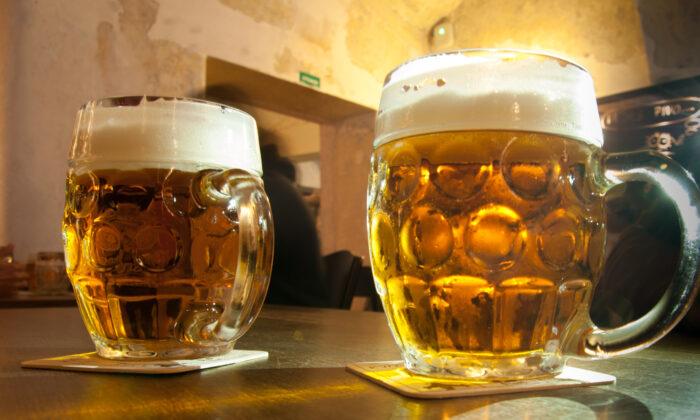I wasn’t quite sure what to expect when my Czech friend Jaroslav suggested a trip to a secret spa. Not exactly a speakeasy, it was tucked away behind Prague’s iconic castle in a district far off the main tourist track, he said. An odd location, maybe, but he said there was good reason for it: The space had once been the place where a Habsburg king commissioned an alchemist to find hidden, healing, magical powers in what’s now the country’s very favorite beverage: beer.
I was in Prague, which is probably the world’s greatest city for getting a good brew. The capital of the Czech Republic, the people there have long loved the good stuff. Some of the best beer ingredients on earth are grown in this country, and Czechs drink more beer, per capita, than anyone else in the world.
And one of the most popular brewing methods was invented in the city of Pilsen, just a short drive (or train ride) from the capital. In 1307, Pilsen was granted the right to brew beer, and many different households created their own blends. But over time, as everyone did their own thing, the quality grew worse and worse.

In a true Czech-style protest, brewmasters, disgusted with their own efforts—and perhaps because of spoilage—dumped dozens of barrels on the steps of the main square. They brought in a known master, Josef Groll, to help create a consistent product. Pilsner was born in 1842, and it’s now consumed around the globe as the world’s most popular beer. If you’ve had Heineken, Budweiser, or Stella Artois, you’ve consumed the product of Groll’s labor.
But Czechs have also found even more creative uses for their preferred drink, something that I’ve experienced on a number of past trips there. At the beer museum in Pilsen, I handled the elements of beer, including all the ingredients, smelling their scent and even rolling the malt and hops around in my mouth. At a 14th-century monastery in Prague’s Lesser Town, just on the other side of the famous Charles Bridge, a therapist took a dark porter created by monks and used it to create a massage oil. A very relaxing, slightly boozy treatment ensued.
And then, there are the beer baths. Increasing in popularity in recent years, you’ll now find a number of them near the Prague city center. But as we drove toward the capital through the fertile fields of rural Bohemia, Jaroslav told me that there’s none quite like Spa Beerland’s Beer Chateau.
Before we reached the city, we made a surprise stop at Krusovice. One of the country’s most historic breweries, the Habsburg Emperor Rudolf II purchased it for the Czech crown back in 1583. Located outside of a small village, we walked around for a while, smelling the barley and hops.
“We have this delivered, unpasteurized, in a tank every day,” Jaroslav said.
Soon, we arrived in Prague, fighting rush hour traffic and winding through modern apartment blocks. Then, all of a sudden, we were in a different world. The streets became cobblestone. The traffic faded away. Another century—one long ago—closed in, all around us.

Dropping our bags, we took a walk around the district. Tucked away on a hilltop, we were in one of the oldest parts of the city.
“This is the Montmartre of Prague,” Jaroslav said. “Can you imagine what it was like in the 16th century?”
That was a time of magic and alchemy in this city, he said, with people seeking the fountain of youth. We made a loop, passing the massive palaces and spotting the gothic towers and flying buttresses of St. Vitus Cathedral before returning to the Chateau. It’s a handsome building, carefully restored by Jaroslav himself—he’s one of the owners.
“It was a labor of love,” he said.
Upstairs were three roomy, upscale guest suites. On the main floor, there was a tap with unlimited beer for overnight guests. But downstairs—that’s where the special alchemy happens.


Jaroslav didn’t choose this location by accident or coincidence. Rather, it was there—right in that spot, known as the House of the Golden Pear—that Rudolf installed a man named Tycho Brahe to conduct a series of important experiments. Brahe had worked for the Danish king as an astronomer, at the same time creating medicines from various herbs.
United with Tadeus Hajek, a Czech beer expert, he quickly determined that Zatec hops, which are local, were a key healing ingredient. He concluded—the story goes—that both body and skin could be rejuvenated and that nerves could be soothed and calmed by a whirlpool bath that included both crushed hops and brewer’s yeast. Take a soak, then rest on a bed of hay. And sip beer all through the process—that, he said, makes it all even better.
It’s what we proceeded to do on that night. Jaroslav showed me the baths downstairs, made of oak reclaimed from retired beer barrels.
“It’s a natural feeling, with the same materials,” he said.
A young woman prepared the warm water, mixing in the yeast and hops.
We slid into our respective bathtubs, each equipped with its own beer tap and frosty mug. Looking up, the ceiling shone.
“It’s the same constellations, including a supernova, that Brahe would’ve seen in 1572,” Jaroslav told me.





